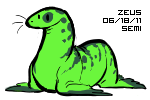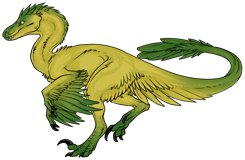This assumes the user already understands the mechanics of breeding (how to do it), and does not cover it. It is a guide on understanding genetics, how they work, how they apply to EX, and how to breed for better offspring in all categories of breeding possible on EX. I don't guarantee however, that you can skim this and run out and breed a perfect-gened dino with 3959485 stats!
The High-Achiever's Guide to Breeding Better Raptors
So, someone mentioned on the boards that there isn't a guide to breeding better raptors, and I decided to fill that gap.
There are many, many other genetics guides out there, and what I will write here can probably be skipped over if you know the basics of genetics and inheritance. A basic understanding of punnett squares will be explained, and how to use more complicated punnett squares (with direct examples from EX) will be provided. It will be labeled clearly in sections, and so you can easily skip past anything you already understand.
1. Basic Genetics (and how they relate to game-play)
Okay, I'm going to assume you already have a basic understanding of genetics. You should recognize and understand the following words. If you do not, you should endeavor to look them up or refer to the Raptorpedia genetics guide before continuing: Phenotype, genotype, dominant, recessive, allele, gene, inheritance, heritable, homozygous, heterozygous.
Now that that's over, lets take a look at EX's genetic code:

The top series of letters refers to non-appearance effecting genetics. These can and do effect gameplay, but will not change the picture you see of your dinosaur. If you look further down, I'll have a list to give a more in-depth explanation of each gene (this can also be found on Raptorpedia!) We'll call these Health-Related Genetics.
The second series of letters are what affect markings. More on marking genetics will be added below!
Ehibited Health-Related genetics work the same as real-life genetics, with a sort of randomness. Basically, your dinosaur has two copies of each gene, and only two copies. One is received from their mom, and one from their dad. When they reproduce, that dinosaur can only contribute one of their genes, and they have a roughly 50% chance of contributing the first of their pair or the second.
Lets look at the Example Dinos Genetics above. They are homozygous for GG, II, oo, RR, tt, and vv. They are heterozygous for Bb, Jj, and Ss.
What that means is that they can ONLY pass on G, I, o, R, v, and t. For the ones they're heterozygous for, however, they have an equal chance of passing on B or b, J or j, and S or s. It's harder to predict the outcomes of breedings where there are a lot of heterozygous genes involved, for that reason.
The whole range of potential offspring can only be understood or predicted by looking at the genotype of the dinosaur's mate--and they are nearly infinite.
2. Punnett Squares 101
Punnett squares are pretty simple, and I'll keep this as simple as possible. Like I said above, inheritance is dictated by the splitting of DNA. Each resulting cell is haploid, which means they only have half of the original dinosaur's genes, but in a fairly random order.
So, I'll use two imaginary dinosaurs: Papa and Mama.
Papa's genetics: BbGGIiJjOoRRSsTtvv
Mama's genetics: BBGgIIJJooRrSsTtVV
Okay, so we've got our parents genetics now. For now, well only focus on one gene at a time, because thats the easiest way to do it.
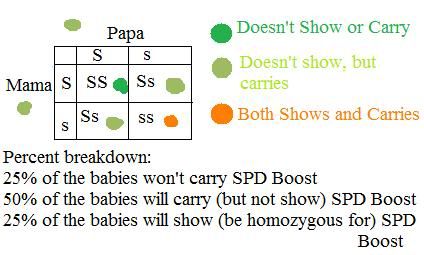
If you take a look at that, its all color-coded for you and should be easy to read. This is tracking the S/s gene, which codes for normal (S) or Speed Boost (s). Because speed boost is a recessive trait (but a desirable one!) were breeding for it (breeding "for it" means we're making sure to breed parents that carry it, because we want babies that have it too). Both parents carry it, so there's a good chance of getting it. The punnett square is a good way of finding out what the chances are.
Okay, so now lets say weve decided that Papa isn't quite good enough for Mama--gasp! And we've found a boy who has two copies of the desirable Speed Boost gene (he's homozygous for it). Let's see how that works:
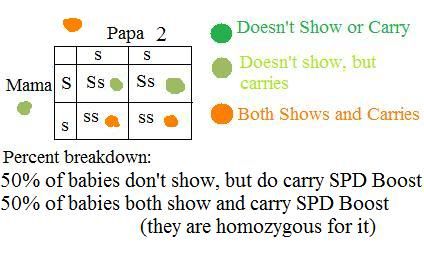
Now we have a 50/50 chance, which is much better than only a chance!
You can work out more on your own, but do keep in mind that just because your raptors have a 50% chance of showing one thing and a 50% chance of showing another doesnt necessarily mean that you have a 50% chance of showing both together. The more genes you're hoping to turn out a certain way, the less likely it is (unless you have a lot of homozygous genes involved!)
Now, let's look at two genes together. So, lets say we want a dinosaur thats Speed Boost homozygous and homozygous for Strength Boost, too. (STR Boost is tt.) But both of our parents are heterozygous for both of those! What now? Now we do a bigger, better punnett square!
We have to put down all possible combinations of genes for SsTt:
ST, St, sT, st. That's four possible combinations for each parent, so we need four columns and four rows.
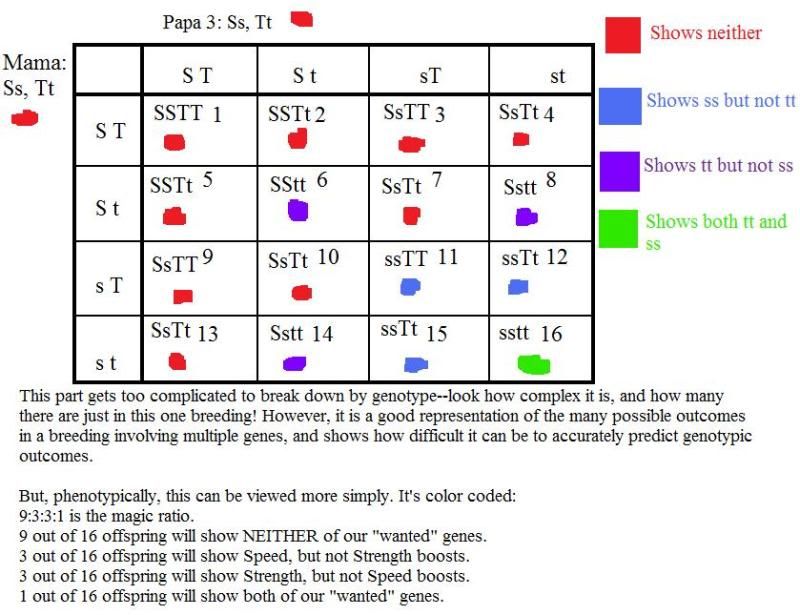
That explains it, for the most part, and gives you an idea of how difficult and complex breeding on EX can get!
3. Quick Reference List of EX Genetics
BB, Bb, or bb: Stands for Slow Brain Syndrome. It's recessive, and reduces your dinosaur's starting INT stats if it's displayed (bb).
GG, Gg, or gg: Stands for Cleft Palette. It's recessive, and reduces your dinosaur's starting Strength stats if it's displayed (gg).
II, Ii, or ii: Stands for Intelligence Boost. It's recessive, and increases your dinos starting INT stats if it's displayed (ii).
JJ, Jj, or jj: Stands for Joint Problems. It's recessive, and decreases your dino's starting SPD stats if it's displayed (jj).
OO, Oo, or oo: Stands for Vocal. It's dominant, and increases your dino's starting INT stats if it's displayed (OO or Oo)
RR, Rr, or rr: Stands for Rage Syndrome. It's recessive, and results in rabies-like behavior: affected animals will attack others in their enclosures and will be unable to participate in trials.
SS, Ss, or ss: Stands for Speed Boost. It's recessive, and increases your dino's starting SPD stats if it's displayed (ss).
TT, Tt, or tt: Stands for Strength Boost. It's recessive, and increases your dino's starting STR stats if it's displayed (tt).
VV, Vv, or vv: Stands for Vibrancy. It's dominant, and increases your dino's starting stats if it's displayed (VV, Vv).
4. How to Predict Offspring Phenotype
This is pretty simple, but must be broken down into 3 parts: color, genetics, and markings.
Color:
Genetics don't affect color. Because color is on a hex code system, any color thats a hex code may be found in markings or base colors. Markings and base colors are independent of one another, so you don't have to worry about that. The best way to predict offspring color is to look at the parents (though there's also the nifty little button that offers the chance to see potential offspring!). If you have a red and a blue, you have about a 40% chance of getting a purple color, and a 30% like mom and 30% like dad. Its like that for marking color, too.
Health-Related Genetics:
These dont really affect how your dinos picture looks.
Marking Genetics
Markings are inherited genetically. Marking genetics are fully as complex as the Health-Related genetics--possibly more so!
Each species has a marking, and set of marking genetics, which are their 'common marking'. That is to say, each has a 'default' marking that is what displays when no recessive genetics are homozygous. The common marking is the "dominant" marking. For Bambiraptors, that is Fauna, while for Atrociraptors that is Blanket, etc. Each species has different markings, using the same set of genetics. Below is a complete section only on Marking Genetics.
5. Understanding Marking Genetics and Breeding for Them
Marking Intensity:
The intensity of the markings are controlled by an incomplete dominant gene: H is the natural state of the animal and in its homozygous form will have no markings. The non-capital version, h, is the gene for the markings. With only one copy of h, in Hh, because it is an incomplete dominant gene there will still be markings visible: we can call them half-markings, or Common. This is similar to the homozygous form, but not as extensive. The homozygous form, hh, is the complete expression of the gene, and results in more extensive Heavy markings. When the natural state is homozygous, or HH, the dinosaur will have no markings.
Marking Genetics
For each species, there 8 possible markings. Each species has its own special set of markings, which may or may not be unique from all other species. *****Only one species is exempt to this; Allosaurus has 9 marking types, but the genetics work the same. To be explained further along****
There are 8 "Types" of genes--each gene is associated with one of these "types", and the genetic code matches that type.
Types of Marking Genetics:
Type 1: AACCDD, AaCcDd, etc.--Where none of the recessive genes are homozygous.
Type 2: aaCCDD, aaCcDD, aaCCDd, aaCcDd-- Where only a is homozygous recessive.
Type 3: AAccDD, AaccDd, AAccDd, etc. -- Where only c is homozygous recessive.
Type 4: AACCdd, AaCcdd, AACcdd, AaCCdd, etc. -- Where only d is homozygous recessive.
Type 5: AAccdd, Aaccdd -- Where both c and d must be homozygous recessive.
Type 6: aaCCdd, aaCcdd -- Where both a and d must be homozygous recessive.
Type 7: aaccDD, aaccDd --Where both a and c must be homozygous recessive.
Type 8: aaccdd -- Where all must be homozygous recessive.
Marking Type Charts for All Species
Albertosaurus:
Giraffe: Type 7
Husky: Type 1
Leopard: Type 3
Raccoon: Type 5
Rattlesnake: Type 6
Siamese: Type 8
Tiger: Type 4
Tribal: Type 2
Allosaurus:
Fauna 1: Type 1
Fauna 2: Also Type 1 (random chance)
Giraffe: Type 7
Husky: Type 2
Leopard: Type 3
Raccoon: Type 5
Rattlesnake: Type 6
Siamese: Type 8
Tiger: Type 4
Anchiornis
Fauna: Type 1
Hawk: Type 6
Husky: Type 7
Leopard: Type 3
Piebald: Type 2
Raccoon: Type 5
Siamese: Type 8
Tiger: Type 4
Atrociraptor
Back stripes: Type 6
Blanket: Type 1
Dalmatian: Type 7
Leopard: Type 3
Panda: Type 5
Pinto: Type 2
Siamese: Type 8
Tiger: Type 4
Bambiraptor
Back stripes: Type 6
Fauna: Type 1
Harlequin: Type 2
Leopard: Type 3
Patches: Type 7
Raccoon: Type 5
Siamese: Type 8
Tiger: Type 4
6. Selecting Parents for Optimal Offspring
Selecting parents for optimal offspring is more an art than a science, and its an art learned through experience and trial and error. I won't be giving away all the secrets--that wouldn't be fair to those who have spent months or longer experimenting and working on their lines to figure out the perfect process for them to just give things away.
But I will point you in the right direction.
First of all, breeding for genetics I've covered that as far as I possibly can, so if you're still unsure on that, just go back and re-read everything I've already covered in the genetics sections.
Second, breeding for color. This is fairly simple; you get a solid idea of what you're going for in your mind and you look for parents similar to what you want, color-wise. Remember, for color inheritance it's really simple: Expect 30% to look like mom, 30% to look like dad, and 40% to look like a mixture of both. Otherwise, use your test-breeding tool liberally and test-breed as many animals as you can to get an idea of what dinos produce what babies.
Third, breeding for markings.
Fourth, breeding for perfects. This one is also simple; the more perfects the parents have (generally speaking!) the more perfects the babies will have. Look for parents with more perfects, or with confirmation that match up well. For example, a dino with Not Many teeth would go well with a dino with Too Overcrowded teeth, because the two should average out to about Perfect, or at least better than either parent.
Fifth, breeding for stats. Less simple; there IS a formula out there that will give a good approximation of stats in babies, but I leave it to you to search for it or not. Stats are affected by the parents stats: the higher the better, and stats added to by items will NOT pass on anything but the base level stats. However, genetics also play a part. INT Boost, SPD Boost, STR boost, Vocal and Vibrancy all can boost starting stats (check Raptorpedia for exact percentages) while Cleft Palette, Slow Brain Syndrome, and Poor Joints can lower starting stats.
7. Preparing Parents for Breeding: How to Get the Best Babies
Breeding for stats is fairly simple to adjust in-game after the birth of the parents. You just have your parents chosen and take the best care possible of them. Battle them every day, 5 times on your own and 1 time in your Club battle, train them every day at the training grounds, and feed them foods that boost their stats. The higher your parent dino's stats, the better the baby's starting stats will be.
Breeding for perfects can be helped with Perfection Potions, which will give your dinosaur all perfects. These can be bought from other players, or you might get lucky and find one, if you know where to look.
Breeding for color can be done fairly easily, by searching for specific colors, by buying or finding color potions to change the colors of your dinos, or, if you have the Scales for it, you can buy colorants, which change the color of your dinosaurs markings.
Breeding for Markings can be done in much the same way as breeding for Health-Related genetics. You pay attention to the marking genes that your raptors have, and look up the marking genes for that species, and use punnett squares to make sure your babies will turn out the way you want. Some markings are much harder to breed for than others!
That being said, the best way to prepare parents for breeding is NOT to breed them at age 10!!! The babies you get at age 10 will be the WORST babies (stats wise) that they will ever produce!!! It's always better to wait a while for their stats to go up and for you to find them the perfect mate before breeding them. Remember, you can breed them from age 10 to age 80, and while it can be terrible to wait, sometimes you get amazing babies by waiting until age 70+!
There are many items in-game that can boost stats and make your dinosaurs better, but at the end of the day it's only your careful preparation, care, and selection of breeding stock that dictates how nice the babies you produce will be.
8. Perfects, Stats, and How they Pass On
Perfects, as I said, are pretty simple to track. There are 5 levels of conformation, which for simplicity sake I will label in the following manner, as each is called something different.
1. Very High
2. High
3. Perfect
4. Low
5. Very Low
ONE EXCEPTION: Length is the only exception, which seems to go linearly, from Terrible length to poor length to average length to okay length to perfect length. This can only be bred for by going for the highest on this you can until you get perfects.
A perfect x perfect cross in a particular category will result in perfects.
A very high x very low cross will usually result in perfects, or a 2 or 4 (which are better than a 1 or 5)
A very high x high cross will usually result in high or very high.
A perfect x very high will usually result in high.
The trend continues in that fashion. Think of it as getting an average: you want the average between the two to be 3. So: 1 + 5 = 6. 6 / 2 = 3 or 2 + 4 = 6. 6 /2 = 3. And so on and so forth, with 3 being Perfect.
Stats pass on in a fairly linear fashion: The higher the stats the parents have, the higher the offsprings stats will be. Parent stats can be raised in numerous ways, listed in the previous section, and offspring stats can be positively or negatively affected by Health-Related genetics. The best way to breed for stats is to wait until your parents are as high in stats as you can get them and to breed for the genes that boost stats while avoiding those that lower stats.
There is a calculator floating around somewhere that discusses stat inheritance more in-depth than this is, but because I do not know where it is, or how accurate it is, I am excluding it from this.
This concludes the tutorial! I know it was fairly basic, but I hope it helps you get a better grasp on breeding in Exhibited!
EDIT: 1/1/2012: Adding Marking Genetics information. More to come on that--keep an eye out!
Posted: 24/04/2011 @ 7:40 pm Edited on 1st Jan 12 @ 8:46pm by Sen
Aand now the spinning...thanks for nothing, you useless reptile.








